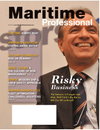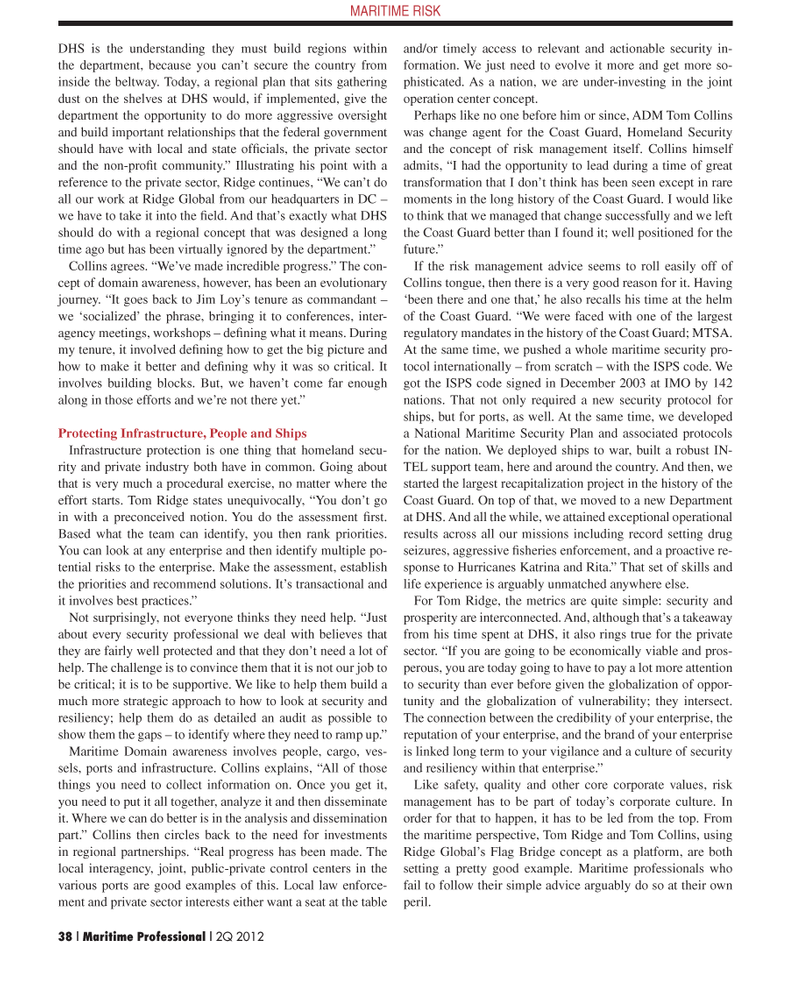
Page 38: of Maritime Logistics Professional Magazine (Q2 2012)
Maritime Risk
Read this page in Pdf, Flash or Html5 edition of Q2 2012 Maritime Logistics Professional Magazine
DHS is the understanding they must build regions within the department, because you can’t secure the country from inside the beltway. Today, a regional plan that sits gathering dust on the shelves at DHS would, if implemented, give the department the opportunity to do more aggressive oversight and build important relationships that the federal government should have with local and state offi cials, the private sector and the non-profi t community.” Illustrating his point with a reference to the private sector, Ridge continues, “We can’t do all our work at Ridge Global from our headquarters in DC – we have to take it into the fi eld. And that’s exactly what DHS should do with a regional concept that was designed a long time ago but has been virtually ignored by the department.”
Collins agrees. “We’ve made incredible progress.” The con- cept of domain awareness, however, has been an evolutionary journey. “It goes back to Jim Loy’s tenure as commandant – we ‘socialized’ the phrase, bringing it to conferences, inter- agency meetings, workshops – defi ning what it means. During my tenure, it involved defi ning how to get the big picture and how to make it better and defi ning why it was so critical. It involves building blocks. But, we haven’t come far enough along in those efforts and we’re not there yet.”
Protecting Infrastructure, People and Ships
Infrastructure protection is one thing that homeland secu- rity and private industry both have in common. Going about that is very much a procedural exercise, no matter where the effort starts. Tom Ridge states unequivocally, “You don’t go in with a preconceived notion. You do the assessment fi rst.
Based what the team can identify, you then rank priorities.
You can look at any enterprise and then identify multiple po- tential risks to the enterprise. Make the assessment, establish the priorities and recommend solutions. It’s transactional and it involves best practices.”
Not surprisingly, not everyone thinks they need help. “Just about every security professional we deal with believes that they are fairly well protected and that they don’t need a lot of help. The challenge is to convince them that it is not our job to be critical; it is to be supportive. We like to help them build a much more strategic approach to how to look at security and resiliency; help them do as detailed an audit as possible to show them the gaps – to identify where they need to ramp up.”
Maritime Domain awareness involves people, cargo, ves- sels, ports and infrastructure. Collins explains, “All of those things you need to collect information on. Once you get it, you need to put it all together, analyze it and then disseminate it. Where we can do better is in the analysis and dissemination part.” Collins then circles back to the need for investments in regional partnerships. “Real progress has been made. The local interagency, joint, public-private control centers in the various ports are good examples of this. Local law enforce- ment and private sector interests either want a seat at the table and/or timely access to relevant and actionable security in- formation. We just need to evolve it more and get more so- phisticated. As a nation, we are under-investing in the joint operation center concept.
Perhaps like no one before him or since, ADM Tom Collins was change agent for the Coast Guard, Homeland Security and the concept of risk management itself. Collins himself admits, “I had the opportunity to lead during a time of great transformation that I don’t think has been seen except in rare moments in the long history of the Coast Guard. I would like to think that we managed that change successfully and we left the Coast Guard better than I found it; well positioned for the future.”
If the risk management advice seems to roll easily off of
Collins tongue, then there is a very good reason for it. Having ‘been there and one that,’ he also recalls his time at the helm of the Coast Guard. “We were faced with one of the largest regulatory mandates in the history of the Coast Guard; MTSA.
At the same time, we pushed a whole maritime security pro- tocol internationally – from scratch – with the ISPS code. We got the ISPS code signed in December 2003 at IMO by 142 nations. That not only required a new security protocol for ships, but for ports, as well. At the same time, we developed a National Maritime Security Plan and associated protocols for the nation. We deployed ships to war, built a robust IN-
TEL support team, here and around the country. And then, we started the largest recapitalization project in the history of the
Coast Guard. On top of that, we moved to a new Department at DHS. And all the while, we attained exceptional operational results across all our missions including record setting drug seizures, aggressive fi sheries enforcement, and a proactive re- sponse to Hurricanes Katrina and Rita.” That set of skills and life experience is arguably unmatched anywhere else.
For Tom Ridge, the metrics are quite simple: security and prosperity are interconnected. And, although that’s a takeaway from his time spent at DHS, it also rings true for the private sector. “If you are going to be economically viable and pros- perous, you are today going to have to pay a lot more attention to security than ever before given the globalization of oppor- tunity and the globalization of vulnerability; they intersect.
The connection between the credibility of your enterprise, the reputation of your enterprise, and the brand of your enterprise is linked long term to your vigilance and a culture of security and resiliency within that enterprise.”
Like safety, quality and other core corporate values, risk management has to be part of today’s corporate culture. In order for that to happen, it has to be led from the top. From the maritime perspective, Tom Ridge and Tom Collins, using
Ridge Global’s Flag Bridge concept as a platform, are both setting a pretty good example. Maritime professionals who fail to follow their simple advice arguably do so at their own peril.
MARITIME RISK 38 | Maritime Professional | 2Q 2012
MP #2 34-49 NEW STYLES.indd 38 5/4/2012 5:12:50 PM

 37
37

 39
39
